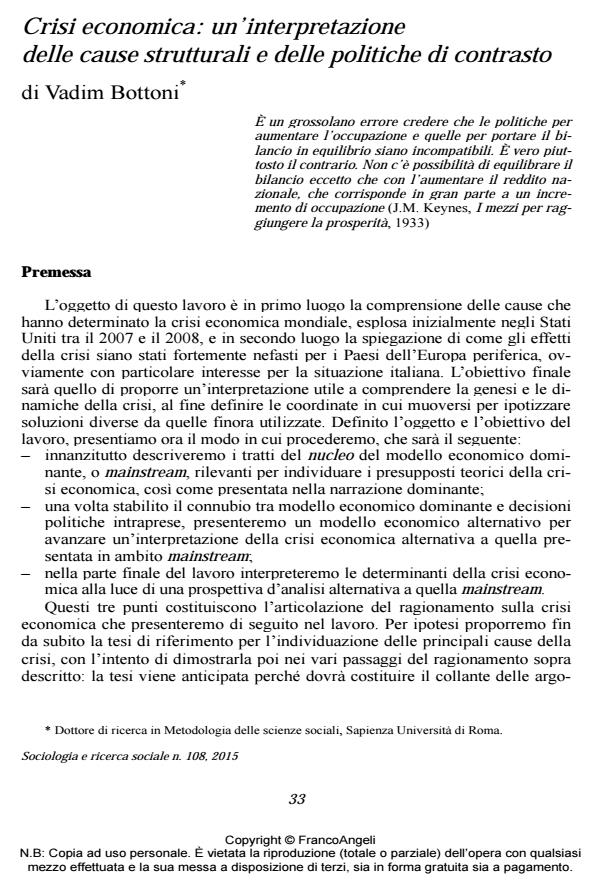Economic Crisis: Interpretation of Causal Structures and Response Policies
Journal title SOCIOLOGIA E RICERCA SOCIALE
Author/s Vadim Bottoni
Publishing Year 2016 Issue 2015/108
Language Italian Pages 40 P. 33-72 File size 351 KB
DOI 10.3280/SR2015-108003
DOI is like a bar code for intellectual property: to have more infomation
click here
Below, you can see the article first page
If you want to buy this article in PDF format, you can do it, following the instructions to buy download credits

FrancoAngeli is member of Publishers International Linking Association, Inc (PILA), a not-for-profit association which run the CrossRef service enabling links to and from online scholarly content.
The central hypothesis of this paper presents an interpretation of the causes and dynamics that characterize the current economic crisis. This interpretation is developed in light of the Keynesian economic model, alternative to the mainstream one, which refers to the neoclassic principles. The importance of the alternative model is given by the fact that the mainstream model has conditioned the institutional response during the economic crisis. The authors propose an interpretation of the crisis based on the alternative model, primarily focused on the dynamics that have characterized the crisis of the Eurozone, to understand its institutional, social and economic causes. The conclusion presents indications to propose effective economic politics, as an alternative to the current and ineffective economic policies
- J.M. Keynes (1937), «The General Theory of Employment», The Quarterly Journal of Economics, XIV pp. 109-23; tr. it. in Ingrao e Ranchetti (1996).
- D. Masciandaro (2014), «Il modello sbagliato della banca universale 2.0», Il Sole 24ore, 1/11.
- J.S. Mill (1844), Essays on Some Unsettled Questions of Political Economy, London, J.W. Parker.
- H. Minsky (1975), John Maynard Keynes, New York, Columbia University Press; tr. it., Keynes e l’instabilità del capitalismo, Torino, Bollati Boringhieri, 2009.
- F. Modigliani (1944), «Liquidity Preference and the Theory of Interest and Money», Econometrica, XII, 45, p. 88.
- Nomisma (2014), Riequilibrio europeo, 7 febbraio, http://www.nomisma.it/index.php/it/newsletter/scenario/item/323-7-febbraio-2014-riequilibrio-europeo/323-7-febbraio-2014 -riequilibrio-europeo.
- L. Pasinetti (1977), La teoria economica della domanda effettiva, in Sviluppo economico e distribuzione del reddito, Bologna, il Mulino.
- D. Patinkin (1949), «Involuntary Unemployment and the Keynesian Supply Function», Economic Journal, 59, pp. 360-83.
- J. Sapir (2015), «La meccanica del default (e dell’uscita dall’euro)», Vocidallestero.it, 26 maggio, http://vocidallestero.it/2015/05/28/sapir-la-meccanica-del-default-e-delluscita-dalleuro/.
- F. Saraceno (2013), «Quei piani di austerità che andrebbero allentati», Il Sole 24ore, 27 aprile.
- J. Stiglitz (2012), «Politics is at the Root of the Problem», The European, 23 aprile, http://www.theeuropean-magazine.com/633-stiglitz-joseph/634-austerity-and-a-new-recession.
- M. Amato, L. Fantacci (2012), Come salvare il mercato dal capitalismo. Idee per un’altra finanza, Roma, Donzelli.
- A. Bagnai (2012), Il tramonto dell’euro. Come e perché la fine della moneta unica salverebbe democrazia e benessere in Europa, Reggio Emilia, Imprimatur.
- A. Bagnai (2014), L’Italia può farcela. Equità, flessibilità e democrazia. Strategie per vivere nella globalizzazione, Milano, Il Saggiatore.
- R. Bocciarelli (2010), «Via libera all’accordo di Basilea 3», Il Sole 24ore, 12 settembre.
- J. Boncoeur (1989), Histoire des idées économiques, Paris, Nathan; tr. it., Le idee dell’economia, Bari, Dedalo, 1997. E. Brancaccio (2008), «Deficit commerciale, crisi di bilancio e politica deflazionista», Studi economici, 96, (pp.109-128), DOI: 10.3280/STE2008-096004
- E. Brancaccio (2011), «Troppo credito alla Germania», Il sole 24 ore, 10 ottobre.
- E. Brancaccio (2012), Anti-Blanchard. Un approccio comparato allo studio della macroeconomia, Milano, FrancoAngeli.
- E. Brancaccio, M. Passarella (2012), L’austerità è di destra. E sta distruggendo l’Europa, Milano, Il Saggiatore.
- E. Brancaccio, G. Zezza (2015), «Perché la Grecia può farci male», Il Mattino, 3 febbraio.
- A. Bruschi (1999), Metodologia delle scienze sociali, Milano, Bruno Mondadori. Cipe (Comitato interministeriale per la programmazione economica) (2014), Andamenti di lungo periodo dell’economia italiana, 9 luglio, http://www.cipecomitato.it/it/eventi/ 2014/giugno/News_0002.
- Financial Times (2013), «The Economist’s Warning», 23 September.
- J.P. Fitoussi, J. Stiglitz (2009), The Ways Out of the Crisis and the Building of a More Cohesive World, Document de Travail, Ofce (17), July, pp. 471-82.
- Francesco (2015), Lettera Enciclica Laudato Sì.
- L. Gallino (2012), «La lettura sbagliata della crisi», la Repubblica, 30 luglio, http://temi.repubblica.it/micromega-online/la-lettura-sbagliata-della-crisi/.
- L. Gallino (2013), Il colpo di Stato di banche e governi. L’attacco alla democrazia in Europa, Torino, Einaudi.
- N. Galloni (2012), Chi ha tradito l’economia italiana?, Roma, Editori Riuniti Univ. Press.
- A. Graziani (1992), Teoria economica. Macroeconomia, Napoli, Edizioni Scientifiche Italiane.
- J.R. Hicks (1936), «Mr. Keynes’ Theory of Employment», Economic Journal, 46, p. 238-53.
- J.R. Hicks (1937), «Mr. Keynes and the Classics: a Suggested Interpretation», Econometrica, 5, pp. 147-59.
- B. Ingrao, F. Ranchetti (1996), Il mercato nel pensiero economico, Hoepli, Milano.
- J.M. Keynes (1936), The General Theory of Employment, Interest and Money, London,
- Macmillan; tr. it., Teoria generale dell’occupazione, dell’interesse e della moneta, Torino, Utet, 2006.
Vadim Bottoni, Crisi economica: un’interpretazione delle cause strutturali e delle politiche di contrasto in "SOCIOLOGIA E RICERCA SOCIALE " 108/2015, pp 33-72, DOI: 10.3280/SR2015-108003